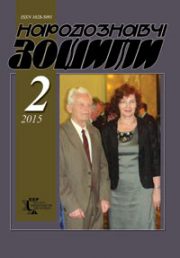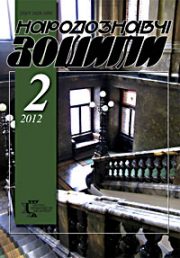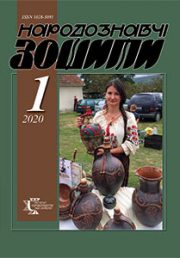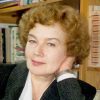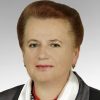The Ethnology Notebooks. 2025. № 5 (185), 1210—1234
UДК: 75.052(477)”19″:7.041.5
SIGNS OF NONCONFORMISM IN THE ICONOLOGY AND CRYPTOCITATIONS OF THE MOSAIC “UNIFICATION OF UKRAINE” BY E. BEZNISKO, M. KRYSTOPCHUK, B. SOYKA AND B. SOROKA IN LVIV
SKOP Mykhailo
- ORCID ID: https://orcid.org/0000-0001-5901-8211
- Doctor of physiology
- Contacts: e-mail: neivanmade@gmail.com
Abstract. This article presents a comprehensive analysis of the work tentatively titled Reunification of Ukraine (1982). The objective is to identify manifestations of nonconformism in its iconography and crypto-quotations. The study focuses on the cultural context, iconography, and iconology of the artwork, as well as its artistic style, references to Ukrainian icon painting and early 20th-century Ukrainian artists, and comparisons with similar thematic compositions.
The relevance of the study lies in the fact that the period of Russian-Ukrainian war, Soviet-era Ukrainian art has become a field of ideological confrontation: Russia appropriates Ukrainian works as Russian, while Ukraine implements decommunization to cleanse public space of Soviet narratives. In response, decolonial initiatives have intensified, particularly those aimed at studying and preserving works that exhibit signs of nonconformism and may serve as tools of cultural self-assertion and anti-Russian counter-propaganda. Therefore, highlighting a mosaic panel that embeds nationalist and religious meanings becomes essential.
To achieve these aims, the study employed methods including historical and cultural contextual analysis, photographic documentation and visual inspection, formal, structural, semantic, comparative, iconographic, and iconological approaches. The analysis reveals that the artwork’s structure refers to Marian iconography. Figures in traditional Kyiv and Bukovynian attire symbolize the reunification of Ukraine and follow the stylistics of the Oranta from Saint Sophia of Kyiv. The depiction of Ukrainian regions as saintly women draws from O. Kulchytska’s The Meeting of Two Ukraines. The Tree of Life symbolizes a bloody past, a veiled Soviet present, and a future represented by its crown resembling a yellow-blue heart. Roots inscribed in a semicircle echo the iconography of the Crucifixion on the Tree of Life. The composition and tree stylization refer to T. Boychuk’s Two Women by the Apple Tree. Characters representing 20th-century events, the integration of Eastern and Western Ukrainians, and the red flag bearing Lenin’s image are, through artistic means, contrasted with the image of Ukraine. Most of these figures have black and squint eyes towards the personification of Ukraine. A comparison with other well-known works on the Reunification of Western Ukraine and the Ukrainian SSR reveals that only the base composition—two women in ethnic dress — is shared.
Conclusions: The analyzed mosaic transcends a typical propagandist narrative. Through artistic techniques, references to Ukrainian iconography and painting, and deliberate contrasts, it clearly differentiates luminous Ukraine from the Soviet figures — fire that surrounds but cannot consume. Despite censorship, the authors succeeded in creating a mosaic that revives Ukrainian sacred art traditions and proclaims the future of a united yellow-blue Ukraine.
Keywords: Ukrainian monumental art, art of the Ukrainian SSR, mosaic, Tree of Life, Saint Sophia of Kyiv, iconography of the Theotokos, Boychukism, Yevhen Beznisko, Mykola Krystopchuk, Bohdan Soika, Bohdan Soroka.
Received 25.06.2025
REFERENCES
- Adzhavenko, N. (2008). Urzuf mosaic. On the 40th anniversary of L.N. Kuzminkov’s Harvest Festival mosaic panel. Vecherniy Mariupol: Newspaper about Mariupol and Mariupolites, 11 (221) [in Russian].
- Skliarenko, H. (2024). Сoncept of M. BOICHUK and the Features of Ukrainian MODERNISM. Folk Art and Ethnology, 1 (401), 27—33. DOI: https://doi.org/10.15407/nte2024.01.027 [in Ukrainian].
- Petrova, I., & Khromova, O. (2022). Monumental art as a means of constructing historical memory in Soviet Ukraine. Skhid, 3 (1), 47—52. DOI: https://doi.org/10.21847/1728-9343.2022.3(1).271713 [in Ukrainian].
- Petrova, O. (2015). From normativity to creative pluralism: Painting of the 1960s—1980s. Tretie oko: Mystetski studii (Pp. 17—32). Kyiv: Feniks [in Ukrainian].
- Lozhkina, A. (2019). Permanent revolution: Ukrainian art of the 20th — early 21st century. Kyiv: ArtHuss [in Ukrainian].
- Nikiforov, Ye., & Baitsym, P. (2024). Chips: Ukrainian naive mosaics of 1950—1990. Kharkiv: IST Publishing [in Ukrainian].
- Sklyarenko, H. (n. d.). Materials on the history: Monumental and decorative art of Ukraine in the second half of the 20th century. Retrieved from: https://sovietmosaicsinukraine.org/media/uploads/text/Stynopis_G._Sklyarenko_MDArt_Stinopis_Galina_Sklyarenko_MDArt.pdf [in Ukrainian].
- Vyniar, H., & Shpachuk, L. (2002). Dictionary of neologisms of the Ukrainian language at the end of the 20th century (Issue 2). Kryvyi Rih [in Ukrainian].
- Demchuk, R. (2015). Temple consciousness in structuring the mnemotopes of identity. Shapes of Culture, 12, 346—355 [in Ukrainian].
- Smyrna, L. (2017). A century of nonconformism in Ukrainian visual art: Monograph. Institute of Contemporary Art Problems of the National Academy of Arts of Ukraine. Kyiv: Feniks [in Ukrainian].
- Tarnashynska, B., & Lukianenko, M. (Ed.). (2011). The generation of the unbroken: Alla Horska, Opanas Zalivakha, Viktor Zaretskyi, Halyna Sevriuk, Liudmyla Semykina. Ministry of Culture of Ukraine; National Parliamentary Library of Ukraine. Shistdesiatnytstvo: Profili na tli pokolinnia, 13, 200 [in Ukrainian].
- Drozdov, V. (2023). Problems of Soviet monumental propaganda in Western Ukrainian lands in 1944—1953. Naukovyi visnyk Uzhhorodskoho universytetu. Seriia «Istoriia», 2 (49), 39—48. DOI: https://doi.org/10.24144/2523-4498.2(49).2023.290335 [in Ukrainian].
- Nikiforov, Ye., Herman, L., & Balashova, O. (2017). Decommunized: Ukrainian Soviet mosaics. Kyiv: Osnovy [in Ukrainian].
- Petrova, I., & Stovpets, A. (Ed.). (2021). Mosaics of Vinnytsia: Historical and artistic essay. Vinnytsia: Tvory [in Ukrainian].
- Chernov, O., & Ivanov, S. (2020). All shades of Mariupol mosaics. Mariupol: Vydavnychyi dim Melitopolskoi miskoï drukarni [in Ukrainian].
- Horska, A., & Yatskovska, A. (Ed.). (2024). Art monograph. Kyiv: Rodovid [in Ukrainian].
- Zadrozhnnyi, I.-V. (1991). Catalogue of the artist’s exhibition works. Kyiv: Spilka khudozhnykiv Ukrainy [in Ukra inian].
- Zadrozhnnyi, I.-V., & Mishchenko, I. (2017). Album of the artist’s works. Kyiv: Sofiia-A. [in Ukrainian].
- (1967). History of Ukrainian art: in 6 vol. (Vol. 5: Soviet art of 1917—1941). Kyiv: Ukrainian Soviet Encyclopedia [in Ukrainian].
- (1968). History of Ukrainian art: in 6 vol. (Vol. 6: Soviet art of 1941—1967). Kyiv: Ukrainian Soviet Encyclopedia [in Ukrainian].
- Skrypchenko, Yu., Hladush, O., Ohranovych, A., & Khokhulyn, A. (1982). Aesthetic design of the city: From the experience of political and architectural-artistic design of Lviv. Kyiv: Budivelnyk [in Ukrainian].
- (1975). Monumental and decorative art in the architecture of Ukraine. Kyiv: Budivelnyk [in Ukrainian].
- Belichko, Yu. (1980). Ukrainian Soviet art during the Civil War. Kyiv: Mystetstvo [in Ukrainian].
- Rossoshynska, N. (Ed.). (1983). State Museum of Ukrainian Folk Decorative Art of the Ukrainian SSR: Album. Kyiv: Mystetstvo [in Ukrainian].
- Manucharova, N. (Ed.). (1960). Ukrainian folk art. Textiles and embroidery. Kyiv: Derzhavne vydavnytstvo obrazotvorchoï mystetskoï i muzychnoyi literatury URSR [in Ukrainian].
- Shemenova, Yu., & Ovcharenko, O. (2021). The art of Myk hailo Boichuk in the process of forming the national consciousness of Ukrainians in the early 20th century. Aktualni pytannia humanitarnykh nauk, 35 (6), 39—44. DOI: https://doi.org/10.24919/2308-4863/35-6-6 [in Ukrainian].
- Koval, I. (2025). The influence of the Boichukist school on the formation of Bolshevik visual propaganda. Etnichna istoriia narodiv Yevropy, 75, 99—108. DOI: https://doi.org/10.17721/2518-1270.2025.75.13 [in Ukrainian].
- Beniakh, N. (2018). The Lviv period in the work of Mykhailo Boichuk, 1910—1914 (PhD dissertation in Art History, 17.00.05). Lviv [in Ukrainian].
- Yekelchyk, S. (2008). Empire of memory: Russian-Ukrainian relations in Soviet historical imagination. Kyiv: Krytyka [in Ukrainian].
- Piddubna, N. (2018). Compositional principles of using mosaic works in the architecture of Lviv from the late 19th to the early 21st century (PhD dissertation in Architecture, 18.00.01). Lviv [in Ukrainian].
- Zubko, L. (2011). Bohdan Soika — The artist’s creative path. Ethnology notebooks, 6 (102), 1040—1045 [in Ukrainian].
- Voloshchak, Yu. (2018). Bohdan Soika. In memoriam. Zbruc. Retrieved from: https://zbruc.eu/node/80309 (accessed May 15, 2025) [in Ukrainian].
- Pavlyshyn, N. (2018). «Bohdan Soika. An artist from Yaniv» — The creative path of an extraordinary talent. Fotohrafii Staroho Lvova. Retrieved from: https://photo-lviv.in.ua/bogdan-soyka-hudozhnik-iz-yanova-tvorchiy-shlyah-nadzvichaynogo-talantu/ (accessed May 15, 2025) [in Ukrainian].
- (2018). Bohdan Soika: Exhibition catalogue Lviv: FOP Kychma [in Ukrainian].
- Hrishchenko, O. (2009). Yevhen Beznisko: Strokes to a creative portrait. Visnyk KhDADM, 2, 32—41 [in Ukrainian].
- (2003). Yevhen Ivanovych Beznisko. Directory of members of the National Union of Artists of Ukraine (P. 314). Kyiv [in Ukrainian].
- Romaniv, O. (2014). Krychtopchuk Mykola Antonovych. Encyclopedia of Modern Ukraine. Kyiv: Institute of Encyclopedic Research of the NAS of Ukraine. Retrieved from: https://esu.com.ua/article-1612 (accessed May 15, 2025) [in Ukrainian].
- Yatsiv, R. (1984, August 22). The joy of creation. Vilna Ukraina [in Ukrainian].
- Neborak, V. (n. d.). Bohdan Soroka, storyteller of histories. Zbruc. Retrieved from: https://zbruc.eu/node/26009 (accessed May 15, 2025) [in Ukrainian].
- Vavrukh, M. (2008). Graphic art of Bohdan Soroka. Ethnology notebooks, 1—2, 134—139 [in Ukrainian].
- Klochko, D. (2025, March 9). The secret language of Ukrainian mosaics (Lecture). Ya Gallery. Lviv [in Ukrainian].
- «Glory to Ukraine!» in the metro. (n. d.). Retrieved from: https://was.media/microformats/slava-ukraine-v-metro/ (accessed May 15, 2025) [in Ukrainian].
- Denysiaka, O. (2024, April 25). The mosaic on Chornovil Avenue will be relocated and preserved. Retrieved from: https://portal.lviv.ua/news/2024/04/25/mozaiku-na-prosp-chornovola-perenesut-ta-zberezhut (accessed May 15, 2025) [in Ukrainian].
- Zherebetska, O. (2012). The work of Mykola Andrushchenko in the second half of the 20th — early 21st century. Scientific Bulletin of the Transcarpathian Art Institute, 2, 79—83 [in Ukrainian].
- Vavrukh, M. (2008). Graphic art of Bohdan Soroka. Ethnology notebooks, 1—2, 134—139 [in Ukrainian].
- Sadlovska, K. (2020). The Institute of National Remembrance proposes to dismantle the «Friendship of Peoples» mosaic in Lviv. Retrieved from: https://suspilne.media/lviv/62071-instituti-nacpamati-proponue-demontuvati-mozaiku-druzba-narodiv-u-lvovi/ (accessed May 15, 2025) [in Ukrainian].
- Lesiv, T. (2021). Icon painting of Halychyna from the late 19th to early 21st century: Artistic image and theoretical discourse (PhD dissertation in Art History, 17.00.05). Lviv: Lviv National Academy of Arts [in Ukrainian].
- Kosmina, O. (n. d.). Features of the «kersetka» from Kyiv region. Retrieved from: https://localhistory.org.ua/rubrics/strii/kersetki-kiyivshchini/ (accessed May 15, 2025) [in Ukrainian].
- Kostyshyna, M. (1996). Ukrainian folk costume of Northern Bukovyna: Traditions and modernity. Chernivtsi: Ruta [in Ukrainian].
- Bohdan Soika. Spring. Prolisok Sanatorium, Morshyn. (n. d.). Retrieved from: https://sovietmosaicsinukraine.org/ua/mo saic/743 (accessed May 15, 2025) [in Ukrainian].
- Korniienko, A. (2020). A mosaic by a famous artist was found in a shed in Cherkasy region. Retrieved from: https://suspilne.media/cherkasy/80915-prolezala-30-rokiv-u-sarai-na-cerkasini-znajsli-avtora-zabutoi-mozaiki/ (accessed May 15, 2025) [in Ukrainian].
- Mykola Krystopchuk. Saint Sophia of Kyiv, 1987. (n. d.). Retrieved from: https://art.lviv-online.com/mykola-krystopchuk/ (accessed May 15, 2025) [in Ukrainian].
- The Cossack said farewell to his kin. (n. d.). Retrieved from: https://www.pisni.org.ua/songs/2374010.html (accessed May 15, 2025) [in Ukrainian].
- (1978). Kyiv Psalter of 1397 from the State Public Library named after M.E. Saltykov-Shchedrin in Leningrad (Vol. 1). Moscow: Iskusstvo [in Russian].
- Andriivska, A. (2016). The chronicle of the Ukrainian people in the graphics of Olena Kulchytska. Visnyk Lvivskoi natsionalnoi akademii mystetstv, 30, 383—394 [in Ukrainian].
- Hoshchitska, T. (2019). The symbol of the tree in world mythologies and the mythologem of the world tree (in comparative context and using the example of traditional culture of the Ukrainian Carpathians). Ethnology notebooks, 3 (147), 622—640. DOI: https://doi.org/10.15407/NZ2019.03.622 [in Ukrainian].
- (2007). History of Ukrainian art: in 5 vol. Art of the 20th century (Vol. 5). Kyiv: M.T. Rylskyi Institute of Art Studies, Folklore and Ethnology of the NAS of Ukraine [in Ukrainian].
- (2019). In the footsteps of ancestors: Liubachiv district. Guidebook. Stryi: Ukrpol Publishing House. Retrieved from: https://fliphtml5.com/ofgmi/alws/Стежками_пред ків%3A_Любачівський_повіт._Путівник/ (accessed May 15, 2025) [in Ukrainian].
- The Conception of the Righteous Anna of the Most Holy Theotokos. Early 18th century. Church of Saint Paraskeva, Radruzh village, Poland. Photo by M. Skop. Retrieved from: https://www.icon.org.ua/gallerys/conception-of-the-most-holy-theotokos-by-saint-anna/#gallery-8 (accessed May 15, 2025) [in Ukrainian].
- Kuevda, V. (2007). Mythological sources of the Ukrainian ethno-cultural model: A psychological aspect. Donetsk: Ukrainian Culturological Center; Donetsk Branch of the Shevchenko Scientific Society [in Ukrainian].
- (1992). Ukrainian folk clothing. Toronto; Philadelphia: World Federation of Ukrainian Women’s Organizations; Commission of Folk Art. Retrieved from: https://irbis-nbuv.gov.ua/cgi-bin/ua/elib.exe?Z21ID=&I21DBN=UKRLIB&P21DBN=UKRLIB&S21STN=1&S21REF=10&S21FMT=online_book&C21COM=S&S21CNR=20&S21P01=0&S21P02=0&S21P03=FF=&S21STR=ukr0002753 (accessed May 15, 2025) [in Ukrainian].
- Soroka, B. (1987). Fortune turns the wheel… (Linocut). Retrieved from: https://www.aksinin.com/art-milieu/36/36-24/ (accessed May 15, 2025) [in Ukrainian].
- (1961). Cultural development in the Ukrainian SSR: Key decisions of the Communist Party and Soviet government: 1917—1960: Collection of documents: in 2 vol. (Vol. 2: June 1941—1960). Kyiv: State Publishing House of Political Literature of the Ukrainian SSR [in Ukrainian].
- Yunak, O., & Fatalchuk, V. (1975). Beautiful Ukraine — reunited, united! 1945. In: The Ukrainian SSR in the Great Patriotic War of the Soviet Union 1941—1945 (Vol. 1—3). Kyiv: Politizdat. Retrieved from: https://violity.com/ua/112694597-ukrainskaya-ssr-vo-velikoj-otechestvennoj-vojne-3-toma (accessed May 15, 2025) [in Russian].
- Perspective of Doroshenka Street and decorative panel on the end wall of the building. (n. d.). Center for Urban History. Retrieved from: https://uma.lvivcenter.org/uk/photos/1801 (accessed May 15, 2025) [in Ukrainian].
